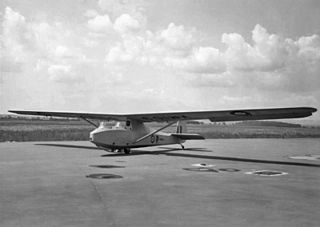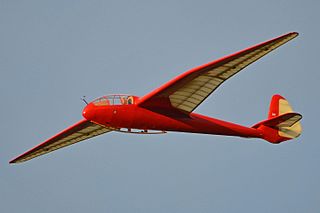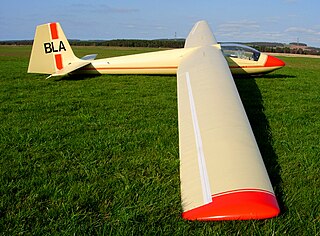Related Research Articles

The Slingsby Type 42 Eagle was a two-seat glider designed in England from 1952.

The Slingsby T.30 Prefect is a 1948 British modernisation of the 1932 single-seat Grunau Baby glider. About 53 were built for civil and military training purposes.
The Slingsby Type 26 Kite 2 was a post World War II development of the Slingsby Kite, a single seat medium performance sailplane. It sold in small numbers.

The Slingsby T.24 Falcon 4 was a two-seat training glider designed in the UK just after World War II for ATC use. It was judged too expensive for production and only three were completed.

The Slingsby T.43 Skylark 3 was a single seat Open Class sailplane developed from the Skylark 2 with an extended wingspan. It won the 1960 World Gliding Championships.

The Slingsby T.13 Petrel was a British single-seat competition glider built by Slingsby Sailplanes just before World War II.

The Slingsby T.50 Skylark 4 was a British single seat competition glider built by Slingsby Sailplanes in the early 1960s. It sold in numbers and had success at national, though not world level competition.
The Buxton Hjordis was a single-seat sailplane built by Slingsby Sailplanes Ltd. in the UK to a design by G.M Buxton. Only one was constructed and was flown by Philip Wills at competitions in Europe between 1935-7.

The Handasyde glider was a single-seat monoplane glider, designed specifically for the first British gliding competition held at Itford Hill in 1922, an endurance event. It finished in second place to a French tandem-wing machine.
The Gordon England glider was a single seat glider designed specifically for the first British gliding competition held at Itford Hill in 1922, an endurance event. It made some competition flights but was damaged on the last day.
The Sayers S.C.W. was a single seat monoplane glider, designed specifically for the first British gliding competition held at Itford Hill in 1922, an endurance event. Unresolved control problems stopped it from making any competitive flights, but it flew successfully later in the year. It was destroyed on the ground by a storm in December 1922.

The Abbott-Baynes Scud 1 was a parasol-winged single seat glider intended to introduce pilots to soaring flight. It was built in the United Kingdom and first flew in 1931.

The Abbott-Baynes Scud 2 was a 1930s high-performance sailplane, built in the UK. It was a development of the intermediate-level Scud 1 with a new, high aspect ratio wing.
The Dart Cambridge was a single-seat competition sailplane built in the United Kingdom in the 1930s. A development of the Grunau Baby, only two were built, flying with gliding clubs.

The Manuel Crested and Willow Wrens formed a series of wooden, single-seat gliders designed in the UK by W. L. Manuel in the early 1930s, intended for slope soaring. Some were built by the designer, others from plans he supplied. The Dunstable Kestrel was a further development.
The Penrose Pegasus was a 1930s high-wing, single-seat, wooden glider from the UK. Designed, built and flown by Harald Penrose until the start of World War II, only one was built at the time though a reproduction was constructed in the 1990s.
The Radlock Trainer was a single seat primary glider designed and built by members of the Hull Experimental Gliding Club as a basic trainer for their own use in the early 1930s. It was a simple, single exposed seat, wooden glider with a parasol wing.
The Reynard R.4 Primary was an open seat primary glider with an open girder fuselage and a high, wire braced wing. It was designed and built in the UK in 1930 and a few served Gliding Clubs in England and Ireland.

The Scott Viking 1 was a single seat, high-performance glider designed and built in the UK just before the Second World War. Only four were constructed, one setting records in Argentina and another remaining active into the 1980s.
The Stedman TS-1 City of Leeds was a parasol wing wooden sailplane, seating two in tandem open cockpits. Only one was built, by its designer in 1934; it remained active until the outbreak of World War II.
References
- 1 2 3 4 5 6 7 8 9 10 Ellison, Norman (1971). British Gliders and Sailplanes. London: A & C Black Ltd. p. 172. ISBN 978-0-7136-1189-2.
- 1 2 3 "Captain Needham discusses the Nyborg sailplane" (PDF). Sailplane & Glider. 3 (9): 103–5. 2 May 1932.
- 1 2 3 4 5 6 "Private Flying and Gliding". Flight . Vol. XXIV no. 14. 1 April 1932. pp. 280–1.
- 1 2 Ellison, Norman (1971). British Gliders and Sailplanes. London: A & C Black Ltd. pp. 148–9. ISBN 978-0-7136-1189-2.
- 1 2 3 4 "Performance of the Nyborg glider" (PDF). Sailplane & Glider. 4 (1): 6. 20 January 1933.
- 1 2 3 "The Nyborg sailplane again" (PDF). Sailplane & Gliding. VII (4): 203. August 1956. Archived from the original (PDF) on 6 April 2012.
- 1 2 Ellis, Ken (2010). Wrecks & Relics (22 ed.). Manchester: Crecy. p. 219. ISBN 978-0-85979-150-2.
- ↑ "Strange encounters of a Nyborg kind" (PDF). Veteran Glider Club News. 110: 10–11. Winter 2003.
- 1 2 3 "Correspondence - the Nyborg sailplane" (PDF). Sailplane & Glider. 4 (3): 34. 17 February 1933.